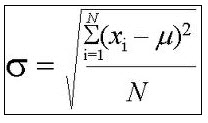Gamma Coefficient Calculator
Instructions: This Gamma Coefficient Calculator computes the value of Gamma, which measures the strength of the association between two ordinal variables. Please first indicate the number of columns and rows for the cross tabulation, and then type the table data:
Learn More About the Gamma Coefficient
The Gamma statistic \(G\) is a statistic used to measure the strength of association between two ordinal variables, by assessing the proportional reduction of error (PRE) by considering the independent variable when compared to ignoring the independent variable in the prediction of the dependent variable.
The Gamma (G) statistic takes values from -1 to 1. Values close to 0 indicate a weak association between the variables and absolute values close to 1 indicate a strong association between the variables.

Gamma Coefficient Formula
The Gamma statistic is a symmetrical measure, in the sense that its value does not depend on which variable is considered to be the independent variable.
Gamma is a measure of effect size, that is usually going along with a chi-square test of independence, which is used to assess the statistical significance of the relationship between the variables, and the Gamma coefficient is used to asses the size of the effect.
Gamma is not the only measure of effect size used along with the Chi-Square test of independence, but it is one of the most popular ones due to its interpretability. Indeed, the proportional reduction of error (PRE) is a very easy to relate and understand metric
The Gamma statistic is computed using the following formula:
\[G = \frac{N_s - N_d}{N_s + N_d} \]where \(N_s\) corresponds to the number of concordant pairs and \(N_d\) corresponds to the number of discordant pairs \(\Box\)
How do you interpret the Gamma coefficient?
First of all, let us recall that Gamma can take values between -1 and 1, and negative values indicate a negative association, and positive values indicate a positive association. Values closer to 1 (or -1) indicate stronger associations.
A positive association means that higher levels on one variable tend to be associated with higher levels of the other variable. On the other hand, negative association means that higher levels on one variable tend to be associated with lower levels of the other variable.
Perhaps the most useful of interpreting Gamma is by recalling its proportional reduction of error (PRE). For example, a Gamma equal to 0.25 indicates a positive association where higher levels of one variable tend to be paired with higher levels of the other, and more specifically, there is reduction of 25% in the error of prediction when using the independent variable to predict the other variable.
How are Lambda and Gamma coefficient related?
Both the Gamma and the Lambda coefficient have several elements in common, along with some differences as well. One thing in common is that they are both measures of effect size for the relationship between categorical variables.
Another similarity is that they both are highly interpretable, as they both measure the corresponding proportional reduction of error (PRE). One difference is that Gamma is especially used for ordinal variables, whereas Gamma is used for nominal variables.
What does a gamma value mean?
Gamma is a measure of effect size. Especifically, Gamma is measured as a proportion of reduction of error (PRE). So then, when Gamma is 0, there is 0% reduction of error, and then the variables aren't related.



